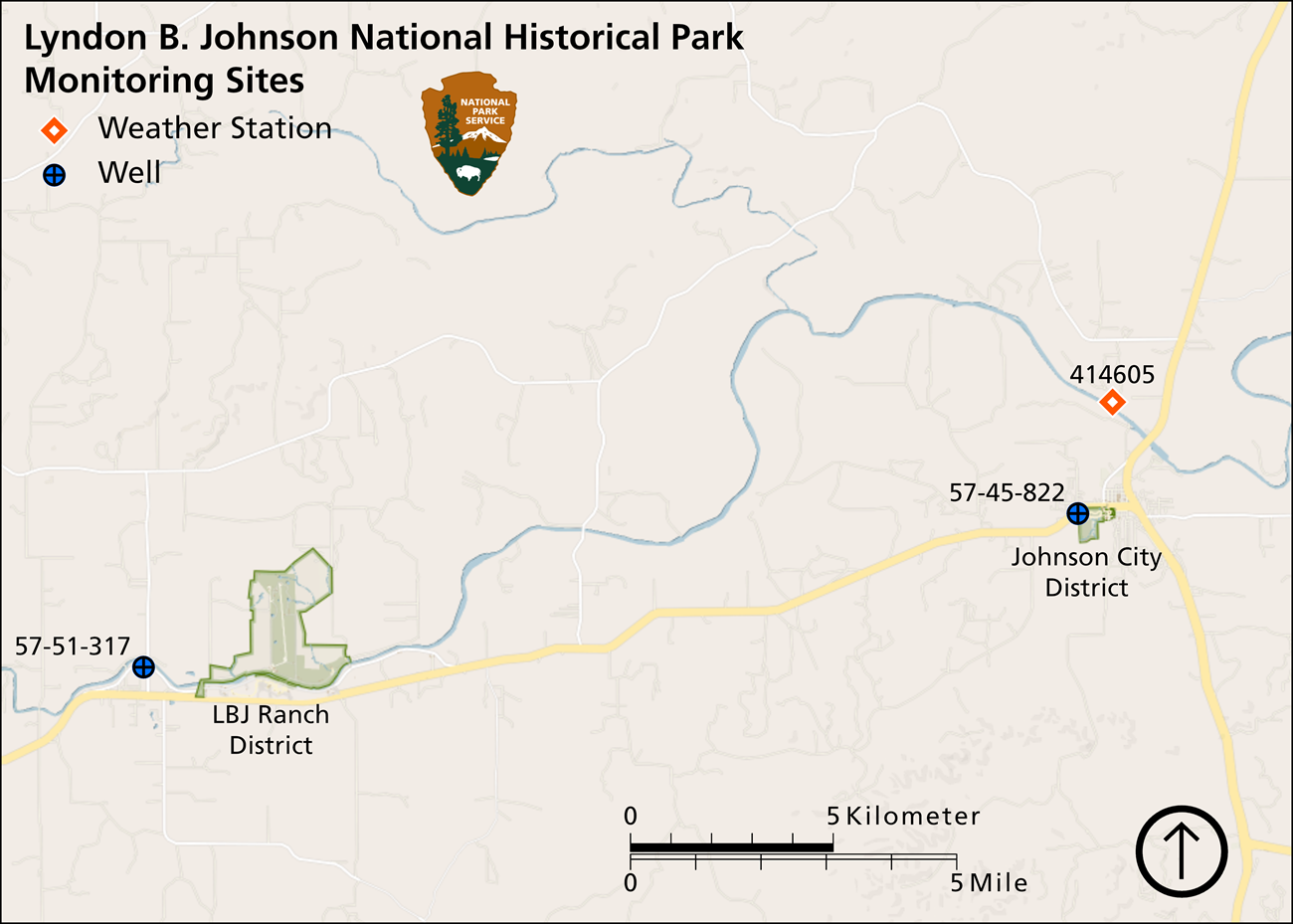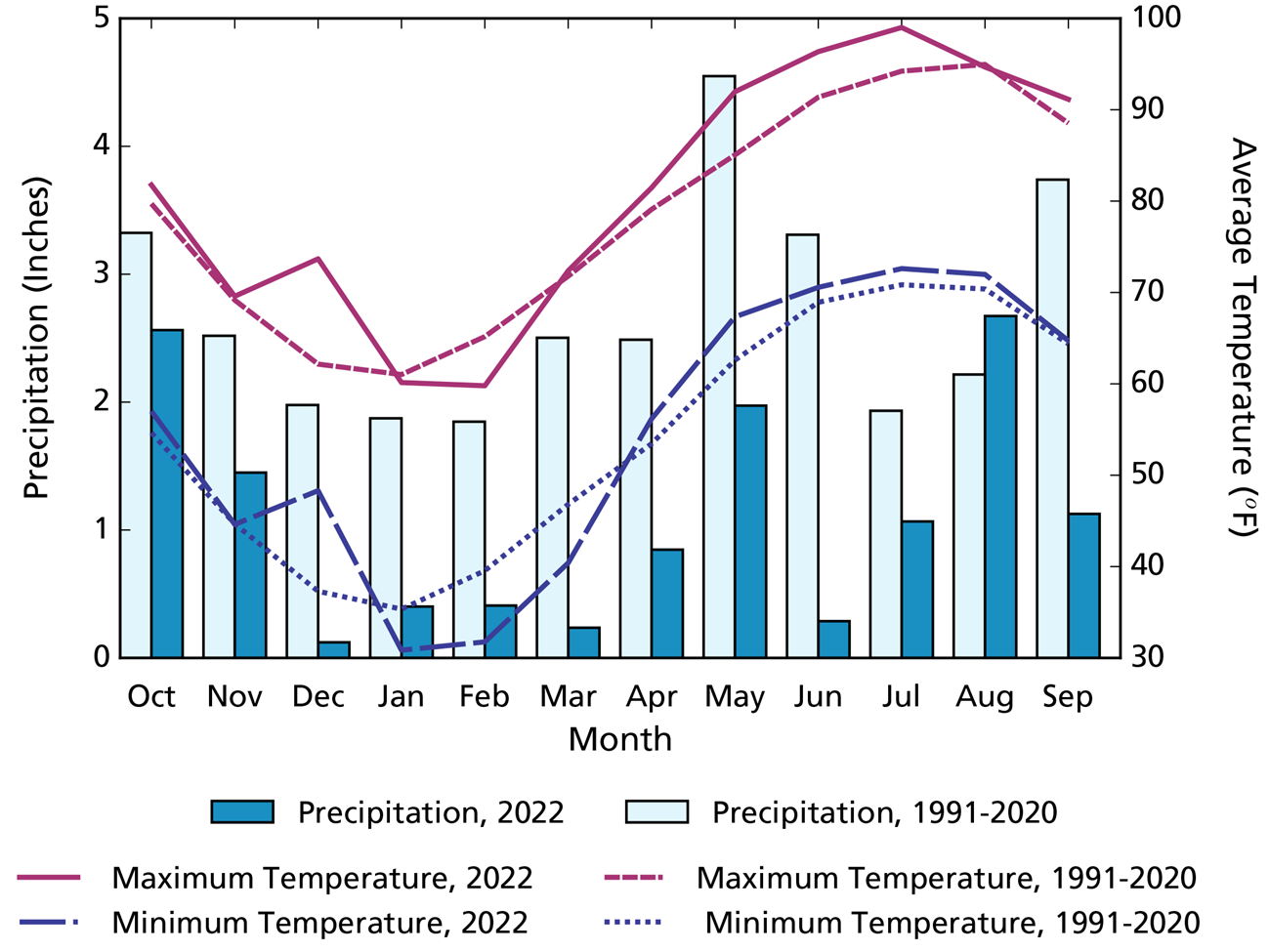Last updated: March 19, 2025
Article
Climate and Water Monitoring at Lyndon B. Johnson National Historical Park: Water Year 2022

NPS/Cynthia Dorminey
Overview
Together, climate and hydrology shape ecosystems and the services they provide, particularly in arid and semi-arid ecosystems (Woodhouse and Overpeck 1998). Understanding changes in climate, groundwater, and surface water is key to assessing the condition of park natural resources—and often, cultural resources.
At Lyndon B. Johnson National Historical Park (Figure 1), Southern Plains Network scientists study how ecosystems may be changing by taking measurements of key resources, or “vital signs,” year after year—much as a doctor keeps track of a patient’s vital signs. This long-term ecological monitoring provides early warning of potential problems, allowing managers to mitigate them before they become worse. At Lyndon B. Johnson National Historical Park, we monitor climate and groundwater, among other vital signs.
Groundwater conditions are closely related to climate conditions. Because they are better understood together, we report on climate in conjunction with water resources. Reporting is by water year (WY), which begins in October of the previous calendar year and goes through September of the water year (e.g., WY2022 runs from October 2021 through September 2022).
This article reports the results of climate and groundwater monitoring done at Lyndon B. Johnson National Historical Park (Figure 1) in WY2022.
Reference: Woodhouse, C. A., and J. T. Overpeck. 1998. 2000 years of drought variability in the central United States. Bulletin of the American Meteorological Society 79(12): 2693–2714. https://doi.org/10.1175/1520-0477(1998)079%3C2693:YODVIT%3E2.0.CO;2

NPS
Climate and Weather
There is often confusion over the terms “weather” and “climate.” In short, weather describes instantaneous meteorological conditions (e.g., it’s currently raining or snowing, it’s a hot or frigid day). Climate reflects patterns of weather at a given place over longer periods of time (seasons to years). Climate is the primary driver of ecological processes on earth. Climate and weather information provide context for understanding the status or condition of other park resources.
Methods
A National Oceanic and Atmospheric Administration Cooperative Observer Program (NOAA COOP) weather station (Johnson City 2N 414605) has been operational near Lyndon B. Johnson National Historical Park since 1964 (see Figure 1). This station typically provides a reliable climate dataset. However, in WY2022 the station was missing data for 41 days. As a substitute, climate analyses in this year’s report use 30-year averages (1991–2020) and gridded surface meteorological (GRIDMET) data from the location of the Airplane Hanger Visitor Center at the LBJ Ranch District. Subsequent reports may revert to the weather stations as the data source, depending on future data quality.
GRIDMET is a spatial climate dataset at a 4-km resolution that is interpolated using weather station data, topography, and other observational and modeled land-surface data. Temperature and precipitation estimated from GRIDMET may vary from actual weather at a particular location, depending on the availability of weather station data and the difference in elevation between the location and that assigned to a grid cell. Data from the NOAA COOP weather station and GRIDMET are available through Climate Analyzer.

NPS
Results for Water Year 2022
Precipitation
Annual precipitation at Lyndon B. Johnson National Historical Park in WY2022 was 13.15″ (33.4 cm; Figure 2), which was 19.12″ (48.6 cm) less than the 1991–2020 annual average. All months except August received less precipitation than the 1991–2020 average. Six months received 30% or less of the average precipitation: December, January, February, March, June, and September.
Air Temperature
The mean annual maximum temperature at Lyndon B. Johnson National Historical Park in WY2022 was 81.1°F (27.3°C), 2.5°F (1.4°C) above the 1991–2020 average. The mean annual minimum temperature in WY2022 was 54.8°F (12.7°C), 0.7°F (0.4°C) above the 1991–2020 average. Mean monthly maximum and minimum temperatures in WY2022 differed by as much as 11.5°F (6.4°C; see December as an example) relative to the 1991–2020 monthly averages (Figure 2). Monthly mean maximum and minimum temperatures were generally above average for most of the year. January and February were the only two months during which both mean maximum and minimum temperatures were cooler than average.

NPS
Drought
Reconnaissance drought index (Tsakiris and Vangelis 2005) provides a measure of drought severity and extent relative to the long-term climate. It is based on the ratio of average precipitation to average potential evapotranspiration (the amount of water loss that would occur from evaporation and plant transpiration if the water supply was unlimited) over short periods of time (seasons to years). The reconnaissance drought index for Lyndon B. Johnson National Historical Park indicates that WY2022 was the second driest of the last 32 water years from the perspective of both precipitation and potential evapotranspiration (Figure 3).
Reference: Tsakiris G., and H. Vangelis. 2005. Establishing a drought index incorporating evapotranspiration. European Water 9: 3–11.

NPS

NPS
Groundwater
Groundwater is one of the most critical natural resources of the Southern Plains and American Southwest, providing drinking water, irrigating crops, and sustaining rivers, streams, and springs throughout the region.
Methods
Lyndon B. Johnson National Historical Park groundwater is monitored at two wells outside the park by the Texas Water Development Board (TWDB Figure 1). Well 57-51-317 is 1 mile (1.61 km) west of the LBJ Ranch District and is monitored twice a year. Well 57-45-822 is adjacent to the western edge of the Johnson City District and is monitored monthly. Data are available at the TWDB Database.
Recent Findings
Average depth to water at well 57-45-822 in WY2022 was 51.04 ft below ground surface (bgs), which was higher than the previous year average (Table 1). Average depth to water at well 57-51-317 in WY2022 was 29.05 ft bgs, slightly lower than the previous water year. Well 57-45-822 shows substantial seasonal variation, likely in response to precipitation and associated shallow recharge (Figure 4). Well 57-51-317 does not exhibit high inter-year variability, likely because it is situated 500 ft (152 m) from the Pedernales River. The monitoring data indicate that water level in both wells is declining over their respective periods of record.
Table 1. Groundwater monitoring results in water year 2022 (WY2022), Lyndon B. Johnson National Historical Park (amsl = above mean sea level; bgs = below ground surface).
| State Well Number | Location | Wellhead Elevation | Depth to Water (ft bgs) |
Water Level Elevation (ft amsl) |
Change in Elevation from WY2021 (± ft) |
Change in Elevation from Earliest Recorded Water Level (± ft) |
|---|---|---|---|---|---|---|
| 57-45-822 | 14 ft west of the Johnson City District | 1,233 | 51.04 | 1,181.96 | 1.02 | -15.52 (2004) |
| 57-51-317 | 1 mile west of LBJ Ranch District | 1,447 | 29.05 | 1,417.95 | -0.05 | -2.60 (2016) |

NPS
Article created by the Southern Plains Inventory and Monitoring Network.
Report Citation
Authors: Kara Raymond, Andy Ray
Raymond, K., and A. Ray. 2024. Climate and Water Monitoring at Lyndon B. Johnson National Historical Park: Water Year 2022. Southern Plains Network, National Park Service, Pecos, New Mexico.
